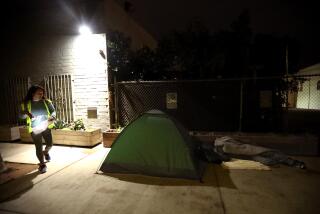Povertyâs new address is in suburbs
Bucking longstanding patterns in the United States, more poor people now live in the nationâs suburbs than in urban areas, according to a new analysis.
As poverty mounted throughout the nation over the past decade, the number of poor people living in suburbs surged 67% between 2000 and 2011 -- a much bigger jump than in cities, researchers for the Brookings Institution said in a book published today. Suburbs still have a smaller percentage of their population living in poverty than cities do, but the sheer number of poor people scattered in the suburbs has jumped beyond that of cities.
Authors Elizabeth Kneebone and Alan Berube cited a long list of reasons for the shift.
More poor people moved to the suburbs, pulled by more affordable homes or pushed by urban gentrification, the authors said. Some used the increased mobility of housing vouchers, which used to be restricted by area, to seek better schools and safer neighborhoods in suburbia. Still others, including immigrants, followed jobs as the booming suburbs demanded more workers, many for low-paying, service-sector jobs.
Change also came from within. More people in the suburbs slipped into poverty as manufacturing jobs disappeared, the authors found. The housing boom and bust also walloped many homeowners on the outer ridges of metropolitan areas, hitting pocketbooks hard. On top of that, the booming numbers of poor people in the suburbs were driven, in part, by the exploding growth of the suburbs themselves.
The shift caught many communities by surprise, the authors found, with public and private agencies unprepared to meet the need in suburban areas.
âThe myth of suburban prosperity has been a stubborn one,â said Christopher Niedt, who as academic director of the National Center for Suburban Studies at Hofstra University is familiar with the trend Brookings described. Even as suburban poverty emerged, âmany poorer communities were so segregated from the wealthy in suburbs that many people were able to ignore it.â
In Irvine, one of the fastest-growing cities in California, the estimated number of poor people rose from roughly 12,400 to nearly 21,000 in a decade, Brookings found in its analysis of U.S. Census data. Every month, hundreds of struggling families call or stop into the Irvine offices of Families Forward -- far more people than the Orange County nonprofit can help house. It once handed out groceries to roughly 25 families a week. Now itâs more than 160.
In Irvine and other Orange County suburbs, âeverything is nicely maintained. Things look good on the surface,â said Margie Wakeham, executive director of Families Forward. âBut the need has just skyrocketed.â
That growth reflects the rapid growth of Irvine as a whole, said Craig Reem, communications director for the city. Although there are more poor people living in Irvine than before, the percentage of people living in poverty increased only slightly, according to the Brookings data. Irvine has set a citywide goal for affordable housing and boasts a range of supportive services to help those in need, Reem said.
As poverty shifted to the suburbs across the country, however, help has not always kept pace, Brookings researchers said. Many suburbs are thin on safety nets. Public transportation is often scant, making it harder for the suburban poor to reach jobs and assistance.
In some communities, tensions have erupted. In Lancaster and Palmdale, where the number of poor people rose by roughly half, black and Latino families using housing vouchers alleged that they were harassed through repeated inspections. Their lawsuit was later dropped after changes were promised.
Some of the highest suburban poverty rates in the country are found in other parts of California, such as the areas ringing Bakersfield and Delano, where more than a quarter of suburbanites are poor. However, while the number of poor people in suburban areas now outstrips those in urban centers, the average U.S. suburb still has a much smaller percentage of its people living in poverty -- 12% -- than the urban average of 22%.
Because of that fact, programs combating poverty have historically been geared toward cities, such as revitalizing urban neighborhoods.
But targeting neighborhoods doesnât work in suburbs where poor people are scattered. Coordinating programs across smaller communities means braving a thicket of different requirements.
Decades after the federal War on Poverty began, âitâs hard to change course,â said Scott Allard, associate professor at the University of Chicagoâs School of Social Service Administration. âJust because thereâs rising poverty in suburbs doesnât mean thereâs less poverty in cities now.â
Kneebone and Berube suggested that the federal government create a new, competitive grant for regional programs to address poverty.
âThis isnât about shifting resources away from the cities,â she said. âBut it underscores the need to think differently.â
Poverty shifted to the suburbs earlier in Los Angeles than nationwide. For decades, roughly half of the poor in Los Angeles, Long Beach, Santa Ana and their outskirts have lived in suburbia, according to Brookingsâ analysis. That percentage rose to 53.4 in 2011.
Brookings defined suburbs as areas within Los Angeles County or Orange County but outside Los Angeles, Long Beach or Santa Ana city limits. That means some parts of Los Angeles with a suburban feel, including much of the San Fernando Valley, counted as urban in its analysis. The study defined poverty using the federal poverty line, which stood at $22,350 for a family of four in 2011.
--
Times staff writer Alejandro Lazo contributed to this report.
More to Read
Sign up for Essential California
The most important California stories and recommendations in your inbox every morning.
You may occasionally receive promotional content from the Los Angeles Times.










